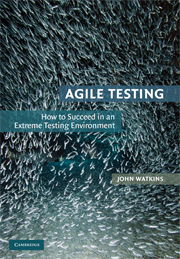Book contents
- Frontmatter
- Contents
- Foreword by Bob Bartlett
- Acknowledgments
- 1 Introduction
- PART 1 REVIEW OF OLD-SCHOOL AND AGILE APPROACHES
- 2 Old-School Development and Testing
- 3 Agile Development and Testing
- PART 2 EVERYONE IS DIFFERENT: AGILE CASE STUDIES
- PART 3 AGILE MY WAY: A PROPOSAL FOR YOUR OWN AGILE TEST PROCESS
- APPENDIX A The Principles of Rapid Application Development
- APPENDIX B The Rules and Practices of Extreme Programming
- Appendix C The Principles of the Dynamic Systems Development Method
- Appendix D The Practices of Scrum
- APPENDIX E Agile Test Script Template
- Appendix F Agile Test Result Record Form Template
- Appendix G Agile Test Summary Report Template
- Appendix H My Agile Process Checklist
- References
- Index
2 - Old-School Development and Testing
Published online by Cambridge University Press: 26 October 2009
- Frontmatter
- Contents
- Foreword by Bob Bartlett
- Acknowledgments
- 1 Introduction
- PART 1 REVIEW OF OLD-SCHOOL AND AGILE APPROACHES
- 2 Old-School Development and Testing
- 3 Agile Development and Testing
- PART 2 EVERYONE IS DIFFERENT: AGILE CASE STUDIES
- PART 3 AGILE MY WAY: A PROPOSAL FOR YOUR OWN AGILE TEST PROCESS
- APPENDIX A The Principles of Rapid Application Development
- APPENDIX B The Rules and Practices of Extreme Programming
- Appendix C The Principles of the Dynamic Systems Development Method
- Appendix D The Practices of Scrum
- APPENDIX E Agile Test Script Template
- Appendix F Agile Test Result Record Form Template
- Appendix G Agile Test Summary Report Template
- Appendix H My Agile Process Checklist
- References
- Index
Summary
Testing is never completed, it's simply abandoned!
Simon MillsIntroduction
This chapter discusses what software development and testing process is, reviews the historical development of process, and concludes by providing a review of the elements of a traditional or “classic” software testing process, providing a useful baseline for the rest of the book to build on.
So, What Is Process?
A process seeks to identify and reuse common elements of some particular approach to achieving a task, and to apply those common elements to other, related tasks. Without these common reusable elements, a process will struggle to provide an effective and efficient means of achieving those tasks, and find it difficult to achieve acceptance and use by other practitioners working in that field.
Test process is no different; we have many different tasks that need to be achieved to deliver effective and efficient testing, and at a variety of different levels of testing from component/unit/developer testing, through integration/module testing, on into systems testing, and through to acceptance testing [4].
Even before testing process was “invented”, good testers have done things in a particular way to achieve good results – such as the best way to find the most defects, to complete testing more quickly or more cheaply, to save time by reusing things they had produced in earlier testing projects (such as a template for a test plan or a test script), or to ensure consistent nomenclature (such as common terms for testing phases).
- Type
- Chapter
- Information
- Agile TestingHow to Succeed in an Extreme Testing Environment, pp. 7 - 17Publisher: Cambridge University PressPrint publication year: 2009



